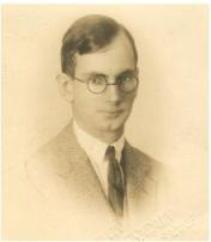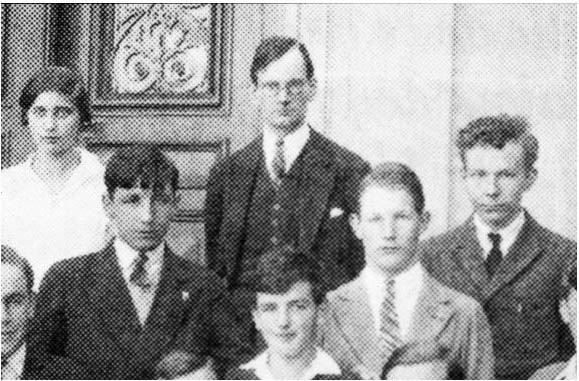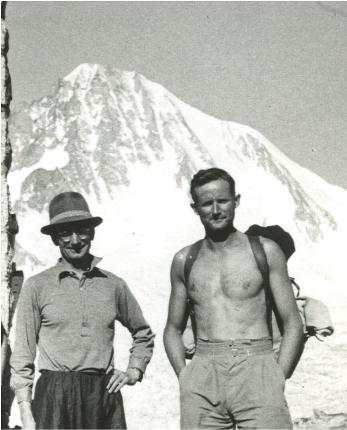 The website is in construction. New files will be uploaded as soon as they are available.
The website is in construction. New files will be uploaded as soon as they are available.
GEORGES DE RHAM
Roche 1903 - Lausanne 1990

- Brief scientific biography
- His commitment to Education
- Essential bibliography
- Articles of interest for mathematics teachers
- Photo gallery
Brief scientific biography
Georges de Rham was born in Roche, in the Canton Vaud, Switzerland, on 10 September 1903. After attending a secondary school specializing in classical studies in Lausanne, and though feeling inclined, since childhood, towards the arts (watercolour and drawing), and fascinated by philosophy and literature, in 1921 he entered the Faculty of Sciences at the University of Lausanne. Many years later, he said that the

De Rham's parental home in Roche

First handwritten page of de Rham's doctoral thesis
"...he did as much as any one man could do to bring mathematicians together, young and old, classical and modern, from the East and West. He found a special joy in the spectacle of younger colleagues adding to the old heritage, and did as much as he could to encourage them."Georges de Rham died in Lausanne on 7 October 1990.
His commitment to Education
According to the testimonies of those who have known Georges de Rham, it seems hard to separate, in his personality and his public engagement, the loyal colleague from the generous friend, the passionate researcher from the fatherly teacher, the brilliant scientist from the brave alpinist. He regarded proving a theorem, delivering a lecture or reaching the top of a mountain as a personal endeavour, requiring a full involvement of the deepest and most precious faculties of the individual, in the name of some kind of transcendental beauty. On the occasion of the centenary of de Rham's birth, his former doctoral student Oscar Burlet remembers that he once explained to him:"For alpinism is not only a physical exercise, but it also a task for the mind, and it allows one to create a marvellous harmony between nature, soul and body."Climbing higher to attain a larger view could be considered as a metaphor for de Rham's constant attempt to advance in abstraction, to gain generality by looking at single problems and objects from above. The development set off by his first proof of the theorem bearing his name moved exactly in the direction of embracing specific questions in a more and more general framework. His scientific approach is based on the comparison of structures, which, unlike in the so-called abstract nonsense, should not be treated as empty buildings, but employed as containers that enable us to grasp different particular cases at the same time. He thus described his first encounter with this method at school:
"I remember a mathematics professor who made me understand the idea of algebra, which consists in making computations with an unknown x, and produces a great simplification in solving arithmetical problems."Clarity and conciseness in exposition were the most evident effects of this principle in his teaching, which, in his global vision of scientific culture, had to be closely intertwined with research. For him both activities required a concrete effort of interpretation, and nourished one another: the joy of discovering surprising connections between distant areas could not be detached from the joy of sharing these "nice things" with others.

De Rham with Armand Borel
De Rham had a subtle charm which drew younger people to him immediately. In those early days at Princeton he would easily mingle with the boisterous postdocs, his exquisite manners contrasting amusingly with our rude ways."De Rham would reply that he just intended to follow the example of Gustave Dumas, who had initiated him to mathematics in Lausanne, and whom he admired for his ability in conveying his passion to others, to make them think autonomously, by "never stopping at the purely formal aspect of a question, but always seeking the deep general idea that enlightens all things from inside, from their centre." This is what he writes, in 1955, in the memorial note published in Elemente der Mathematik. Beyond this, de Rham considered moral straightness, altruism and respect as the very reasons of Dumas' success in teaching. "Never forget that you must love your pupils", was his favourite advice to his assistants. And de Rham cannot refrain from mentioning that his communication talents and human qualities were certainly rooted in his devotion to philosophy and literature. While treasuring the crucial role of teachers, at all levels, from school to university, de Rham firmly condemned the passive attitude of certain students, who only act as recipients, and are not willing to elaborate the subject by themselves (as he had been forced to do, when, at the age of fifteen, the Spanish flu epidemic had kept him away from the collège for several months). He once addressed this recommendation to a class of pupils:
"The courses, the books should only be suggestions and inspirations to work: a mathematician must judge on his own account, he must be critical and must not admit anything which he has not clearly recognized himself as well-founded."He, indeed, used to carefully verify the content of all the articles that he quoted in his papers; in his opinion, this belonged to scientific rigour and intellectual integrity, two values which he obstinately defended throughout his life.
Essential bibliography
G. DE RHAM 1980, Quelques souvenirs des années 1925-1950, Cahiers du séminaire d'histoire des mathématiques, 1, 19-36.
G. DE RHAM 1981, Oeuvres mathématiques, L'Enseignement Mathématique, Université de Genève.
A. WEIL 1952, Sur les théorèmes de de Rham, Commentarii Mathematici Helvetici, 26, 119-145.
H. CARTAN 1970, Les travaux de Georges de Rham sur les variétés différentiables, in A. Haefliger, R. Narasimhan (edited by) Essays on Topology and Related Topics, Mémoires dediés à Georges de Rham, Springer, Berlin, 1-11.
J. MILNOR, O. BURLET 1970, Torsion et type simple d'homotopie, in A. Haefliger, R. Narasimhan (edited by) Essays on Topology and Related Topics, Mémoires dediés è Georges de Rham, Springer, Berlin, 12-17.
J.-P. CHENAUX 1978, Un mathématicien suisse élu à l'Académie des Sciences de Paris. Georges de Rham ou la passion de la simplicité. Interview with Georges de Rham, Journal de Genève, 14 September 1978.
(AUTHOR UNKNOWN)1990, Georges de Rham 1903-1990, L'Enseignement Mathématique, II. série, 36, n. 3/4, 207-214.
R. BOTT 1991, Georges de Rham 1901-1990, Notices of the American Mathematical Society, 38, n. 2, 114-115.
H. CARTAN 1992, La vie et l'œuvre de Georges de Rham, La Vie des Sciences, Comptes Rendus, série générale, 9, n. 5, 453-455.
B. ECKMANN 1992, Georges de Rham 1903-1990, Elemente der Mathematik, 47, n. 3, 118-122.
O. BURLET 2004, Souvenirs de Georges de Rham, Ecole Polytechnique Fédérale de Lausanne, http://igat.epfl.ch/igat/local/pub/derham.pdf
Articles of interest for mathematics teachers
G. DE RHAM 1947, Un peu de mathématiques à propos d'une courbe plane, Elemente der Mathematik, 2, n. 4, 73-76.
G. DE RHAM 1947, Un peu de mathématiques à propos d'une courbe plane (suite), Elemente der Mathematik, 2, n. 5, 89-97.
G. DE RHAM 1952, Sur un théorème de Stieltjes relatif à certaines matrices, Académie Serbe des Sciences, Publications de l'Institut Mathématique, 4, 133-134.
G. DE RHAM 1955, Gustave Dumas, Elemente der Mathematik, 10, n. 6, 121-122.
G. DE RHAM 1957, Sur un exemple de fonction continue sans dérivée, L'Enseignement Mathématique, II. série, 3, 71-72.
Author
Margherita Barile
Università di Bari
barile@dm.uniba.it
Photo gallery

Georges de Rham...
as a secondary school pupil...
as a secondary school pupil...

... in the Alps...

...on the 30th anniversary of the school leaving examination (baccalauréat), 1951 (second row, third from the left)

... as a teacher at the Collège Classique in Lausanne (1928-1932)...

... at one of
the Colloques des Rhodaniens...
the Colloques des Rhodaniens...

... and with Marcel Berger

... in the region of Baltschieder...

...with Michel de Rham, in the Baltschieder valley...

... avec Alfred Tissières, in front of the Bietschorn mountain...

... avec Loulou Boulaz and Daniel Bach in a mountain hut in the Dolomites......

......with his cousin Jean.
